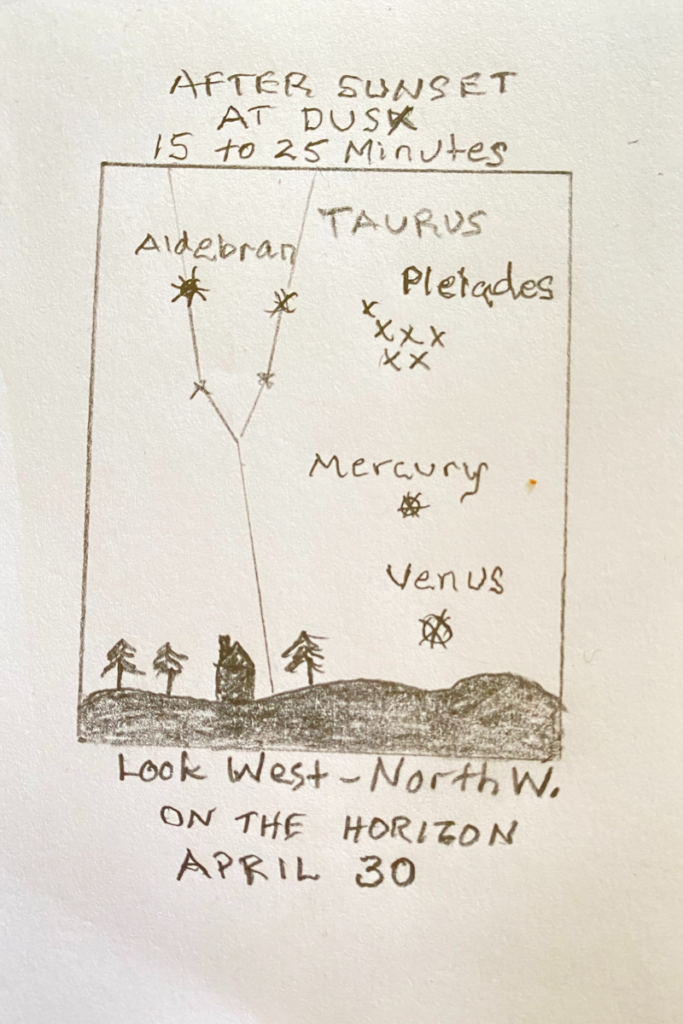April (Meteor) Showers and a Pink Moon
Text and Sketch By Matthew Johnson

Naked-eye observing of the planets in April will take place during early morning or just after sunset. At dawn on April 5, the crescent moon, Jupiter and Saturn form a line along the southeast skyline. At dawn on the 6th, the moon will be just below Saturn, forming a triangle with Jupiter just to its left. On the 7th, the slender crescent moon is now below Jupiter, with Saturn above and to the right.
The various visual geometries that the planets form in relation to each other are due to the differences in their orbital parameters: speed, distance from the earth and sun, orbital inclinations, etc.
When Jupiter and Saturn are close to each other, it is easy to tell them apart. Jupiter is the brighter of the two, reflecting more of the sun’s light because it is larger than Saturn. Jupiter has approximately 318 times the mass of the earth; Saturn has 95 times the earth’s mass. Jupiter’s orbit is also much closer to Earth than Saturn’s—thus, Jupiter always outshines Saturn. With a modest pair of binoculars or a small telescope, Jupiter’s four largest moons and Saturn’s rings easily become visible.
At dusk on the nights of April 15, 16 and 17, just 45 minutes after sunset, Mars is visible and easily discerned from the surrounding stars by its position in relation to the waxing crescent moon. Looking west about halfway up to the zenith on the 15th, the moon is below Mars and just above and to the left of the Pleiades (Seven Sisters). On the 16th, the moon is directly under Mars, and on the 17th it is above and slightly to the left of Mars.
Venus reappears from behind the sun after a long hiatus. It emerges just after sunset on the 18th to once again reign as the “evening star” (although a planet). Look to the west just above the skyline to view brilliant Venus. It will continue to be in view through January 2022.
Two dates not to be missed are April 25 and 30.
Looking west-northwest just 20 minutes after sunset, both Venus and the illusive Mercury are visible together. On the 25th, Venus is along the horizon, with Mercury just to the right. The two planets are next to each other and just below the Pleiades. On the 30th, Venus, Mercury and the Pleiades form a perfect line in the sky, a magnificent tableau to behold.
April’s daylight hours have lengthened considerably since the long nights of December and January. By April’s end, we will be experiencing 12 hours and 44 minutes of daylight, 3.5 more hours of daily sunlight than at the winter solstice.
Meteor showers:
The Lyrid meteor shower will peak the night of April 22. This display of meteors is the result of Earth passing through the tail of the comet C/1861 G1 Thatcher. However, that evening the sky will be illuminated by a waxing gibbous moon. Large and bright, it will be present all night long, blocking out all but the brightest meteor streaks.
Phases of the moon:
April 4: Last quarter (left half of the moon illuminated).
April 12: New moon (no visible moon). The best time of the month to observe faint objects such as distant galaxies.
April 20: First quarter (right half of moon illuminated).
April 27: Full moon. April’s full moon will be a super-moon. A super-moon occurs when the moon is both at its full phase and at perigee (when the moon is closest to Earth). Super-moons are usually seven percent bigger and up to 15 percent brighter than the average full moon.
April’s full moon is known by Native American tribes as the Pink Moon. The color does not relate to the full moon itself, but to the fact that it coincides with the early spring blossoming of phlox subulata, a wildflower with pink blossoms native to eastern North America. Coastal tribes referred to it as the Fish Moon because this was the time when shad began their upstream migrations.
